December 2009 lunar eclipse
| Partial eclipse | |||||||||||||
 Partiality as viewed from Munster, Ireland, 19:43 UTC | |||||||||||||
| Date | December 31, 2009 | ||||||||||||
|---|---|---|---|---|---|---|---|---|---|---|---|---|---|
| Gamma | 0.9765 | ||||||||||||
| Magnitude | 0.0779 | ||||||||||||
| Saros cycle | 115 (57 of 72) | ||||||||||||
| Partiality | 59 minutes, 58 seconds | ||||||||||||
| Penumbral | 251 minutes, 3 seconds | ||||||||||||
| |||||||||||||
A partial lunar eclipse occurred at the Moon’s descending node of orbit on Thursday, December 31, 2009,[1] with an umbral magnitude of 0.0779. A lunar eclipse occurs when the Moon moves into the Earth's shadow, causing the Moon to be darkened. A partial lunar eclipse occurs when one part of the Moon is in the Earth's umbra, while the other part is in the Earth's penumbra. Unlike a solar eclipse, which can only be viewed from a relatively small area of the world, a lunar eclipse may be viewed from anywhere on the night side of Earth. Occurring only about 20 hours before perigee (on January 1, 2010, at 15:30 UTC), the Moon's apparent diameter was larger.[2]
This eclipse was the last of four lunar eclipses in 2009, with the others occurring on February 9 (penumbral), July 7 (penumbral), and August 6 (penumbral).
This lunar eclipse was also notable, because it occurred during a blue moon (a second full moon in December) and was near perigee (making it a supermoon). The next eclipse on New Year's Eve and blue moon will occur on December 31, 2028.
Only a small portion of the Moon entered the Earth's umbral shadow, but there was a distinct darkening visible over the Moon's southern surface at greatest eclipse.
Visibility
[edit]The eclipse was completely visible over Europe, Asia, and much of Africa, seen rising over eastern North America and setting over Australia and the Pacific Ocean.[3]

|
 Hourly motion shown right to left |
 The Moon's hourly motion across the Earth's shadow in the constellation of Gemini. |
 Visibility map | ||
Images
[edit]
Gallery
[edit]
Progression from Degania A, Israel
-
Sheffield, England, 19:14 UTC
-
Qingdao, China, 19:16 UTC
-
Laguja, Estonia, 19:21 UTC
-
Beijing, China
At maximum, 19:22 UTC -
Tokyo, Japan, 19:32 UTC
-
Chennai, India, 19:33 UTC
-
Barcelona, Spain, 19:34 UTC
-
Athens, Greece, 19:34 UTC
-
Helsinki, Finland, 19:47 UTC
-
Nonthaburi, Thailand, 19:59 UTC
-
Belfort, France
Combined images
Eclipse details
[edit]Shown below is a table displaying details about this particular solar eclipse. It describes various parameters pertaining to this eclipse.[4]
| Parameter | Value |
|---|---|
| Penumbral Magnitude | 1.05719 |
| Umbral Magnitude | 0.07793 |
| Gamma | 0.97660 |
| Sun Right Ascension | 18h44m37.2s |
| Sun Declination | -23°02'33.1" |
| Sun Semi-Diameter | 16'15.9" |
| Sun Equatorial Horizontal Parallax | 08.9" |
| Moon Right Ascension | 06h45m22.4s |
| Moon Declination | +24°01'10.3" |
| Moon Semi-Diameter | 16'36.6" |
| Moon Equatorial Horizontal Parallax | 1°00'57.6" |
| ΔT | 66.1 s |
Eclipse season
[edit]This eclipse is part of an eclipse season, a period, roughly every six months, when eclipses occur. Only two (or occasionally three) eclipse seasons occur each year, and each season lasts about 35 days and repeats just short of six months (173 days) later; thus two full eclipse seasons always occur each year. Either two or three eclipses happen each eclipse season. In the sequence below, each eclipse is separated by a fortnight.
| December 31 Descending node (full moon) |
January 15 Ascending node (new moon) |
|---|---|
 |

|
| Partial lunar eclipse Lunar Saros 115 |
Annular solar eclipse Solar Saros 141 |
Related eclipses
[edit]Eclipses in 2009
[edit]- An annular solar eclipse on January 26.
- A penumbral lunar eclipse on February 9.
- A penumbral lunar eclipse on July 7.
- A total solar eclipse on July 22.
- A penumbral lunar eclipse on August 6.
- A partial lunar eclipse on December 31.
Metonic
[edit]- Preceded by: Lunar eclipse of March 14, 2006
- Followed by: Lunar eclipse of October 18, 2013
Tzolkinex
[edit]- Preceded by: Lunar eclipse of November 20, 2002
- Followed by: Lunar eclipse of February 11, 2017
Half-Saros
[edit]- Preceded by: Solar eclipse of December 25, 2000
- Followed by: Solar eclipse of January 6, 2019
Tritos
[edit]- Preceded by: Lunar eclipse of January 31, 1999
- Followed by: Lunar eclipse of November 30, 2020
Lunar Saros 115
[edit]- Preceded by: Lunar eclipse of December 21, 1991
- Followed by: Lunar eclipse of January 12, 2028
Inex
[edit]- Preceded by: Lunar eclipse of January 20, 1981
- Followed by: Lunar eclipse of December 11, 2038
Triad
[edit]- Preceded by: Lunar eclipse of March 3, 1923
- Followed by: Lunar eclipse of October 31, 2096
Lunar eclipses of 2009–2013
[edit]This eclipse is a member of a semester series. An eclipse in a semester series of lunar eclipses repeats approximately every 177 days and 4 hours (a semester) at alternating nodes of the Moon's orbit.[5]
The penumbral lunar eclipses on February 9, 2009 and August 6, 2009 occur in the previous lunar year eclipse set, and the lunar eclipses on April 25, 2013 (partial) and October 18, 2013 (penumbral) occur in the next lunar year eclipse set.
| Lunar eclipse series sets from 2009 to 2013 | ||||||||
|---|---|---|---|---|---|---|---|---|
| Ascending node | Descending node | |||||||
| Saros | Date Viewing |
Type Chart |
Gamma | Saros | Date Viewing |
Type Chart |
Gamma | |
| 110 | 2009 Jul 07
|
Penumbral
|
−1.4916 | 115
|
2009 Dec 31
|
Partial
|
0.9766 | |
120
|
2010 Jun 26
|
Partial
|
−0.7091 | 125
|
2010 Dec 21
|
Total
|
0.3214 | |
130
|
2011 Jun 15
|
Total
|
0.0897 | 135
|
2011 Dec 10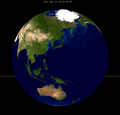
|
Total
|
−0.3882 | |
140
|
2012 Jun 04
|
Partial
|
0.8248 | 145 | 2012 Nov 28
|
Penumbral
|
−1.0869 | |
150
|
2013 May 25
|
Penumbral
|
1.5351 | |||||
Saros 115
[edit]This eclipse is a part of Saros series 115, repeating every 18 years, 11 days, and containing 72 events. The series started with a penumbral lunar eclipse on April 21, 1000. It contains partial eclipses from July 6, 1126 through September 30, 1270; total eclipses from October 11, 1288 through July 20, 1739; and a second set of partial eclipses from July 30, 1757 through February 13, 2082. The series ends at member 72 as a penumbral eclipse on June 13, 2280.
The longest duration of totality was produced by member 36 at 99 minutes, 47 seconds on May 15, 1631. All eclipses in this series occur at the Moon’s descending node of orbit.[6]
| Greatest | First | |||
|---|---|---|---|---|
| The greatest eclipse of the series occurred on 1631 May 15, lasting 99 minutes, 47 seconds.[7] | Penumbral | Partial | Total | Central |
| 1000 Apr 21 |
1126 Jul 06 |
1288 Oct 11 |
1541 Mar 12 | |
| Last | ||||
| Central | Total | Partial | Penumbral | |
| 1685 Jun 16 |
1739 Jul 20 |
2082 Feb 13 |
2280 Jun 13 | |
Eclipses are tabulated in three columns; every third eclipse in the same column is one exeligmos apart, so they all cast shadows over approximately the same parts of the Earth.
| Series members 46–67 occur between 1801 and 2200: | |||||
|---|---|---|---|---|---|
| 46 | 47 | 48 | |||
| 1811 Sep 02 | 1829 Sep 13 | 1847 Sep 24 | |||
| 49 | 50 | 51 | |||
| 1865 Oct 04 | 1883 Oct 16 | 1901 Oct 27 | |||
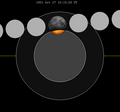
|
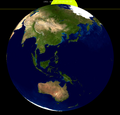
| ||||
| 52 | 53 | 54 | |||
| 1919 Nov 07 | 1937 Nov 18 | 1955 Nov 29 | |||

|

|

|

|
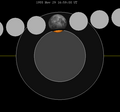
|

|
| 55 | 56 | 57 | |||
| 1973 Dec 10 | 1991 Dec 21 | 2009 Dec 31 | |||

|
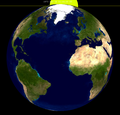
|

|

|

|

|
| 58 | 59 | 60 | |||
| 2028 Jan 12 | 2046 Jan 22 | 2064 Feb 02 | |||

|

|
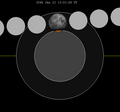
|

|
||
| 61 | 62 | 63 | |||
| 2082 Feb 13 | 2100 Feb 24 | 2118 Mar 07 | |||
| 64 | 65 | 66 | |||
| 2136 Mar 18 | 2154 Mar 29 | 2172 Apr 09 | |||
| 67 | |||||
| 2190 Apr 20 | |||||
Tritos series
[edit]This eclipse is a part of a tritos cycle, repeating at alternating nodes every 135 synodic months (≈ 3986.63 days, or 11 years minus 1 month). Their appearance and longitude are irregular due to a lack of synchronization with the anomalistic month (period of perigee), but groupings of 3 tritos cycles (≈ 33 years minus 3 months) come close (≈ 434.044 anomalistic months), so eclipses are similar in these groupings.
| Series members between 1835 and 2200 | |||||||||
|---|---|---|---|---|---|---|---|---|---|
| 1835 May 12 (Saros 99) |
1846 Apr 11 (Saros 100) |
1868 Feb 08 (Saros 102) |
1879 Jan 08 (Saros 103) | ||||||
| 1933 Aug 05 (Saros 108) | |||||||||
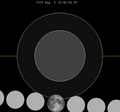
|

| ||||||||
| 1944 Jul 06 (Saros 109) |
1955 Jun 05 (Saros 110) |
1966 May 04 (Saros 111) |
1977 Apr 04 (Saros 112) |
1988 Mar 03 (Saros 113) | |||||

|
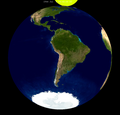
|

|

|
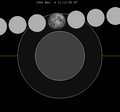
|
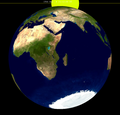
|
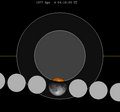
|

|

|
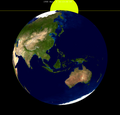
|
| 1999 Jan 31 (Saros 114) |
2009 Dec 31 (Saros 115) |
2020 Nov 30 (Saros 116) |
2031 Oct 30 (Saros 117) |
2042 Sep 29 (Saros 118) | |||||

|

|

|

|
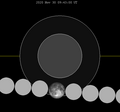
|

|
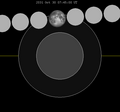
|

|
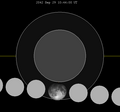
|
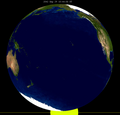
|
| 2053 Aug 29 (Saros 119) |
2064 Jul 28 (Saros 120) |
2075 Jun 28 (Saros 121) |
2086 May 28 (Saros 122) |
2097 Apr 26 (Saros 123) | |||||

|
|||||||||
| 2108 Mar 27 (Saros 124) |
2119 Feb 25 (Saros 125) |
2130 Jan 24 (Saros 126) |
2140 Dec 23 (Saros 127) |
2151 Nov 24 (Saros 128) | |||||
| 2162 Oct 23 (Saros 129) |
2173 Sep 21 (Saros 130) |
2184 Aug 21 (Saros 131) |
2195 Jul 22 (Saros 132) | ||||||
Inex series
[edit]This eclipse is a part of the long period inex cycle, repeating at alternating nodes, every 358 synodic months (≈ 10,571.95 days, or 29 years minus 20 days). Their appearance and longitude are irregular due to a lack of synchronization with the anomalistic month (period of perigee). However, groupings of 3 inex cycles (≈ 87 years minus 2 months) comes close (≈ 1,151.02 anomalistic months), so eclipses are similar in these groupings.
| Series members between 1801 and 2200 | |||||
|---|---|---|---|---|---|
| 1807 May 21 (Saros 108) |
1836 May 01 (Saros 109) |
1865 Apr 11 (Saros 110) | |||
| 1894 Mar 21 (Saros 111) |
1923 Mar 03 (Saros 112) |
1952 Feb 11 (Saros 113) | |||

|

|
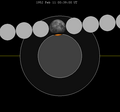
|
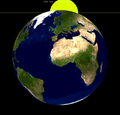
| ||
| 1981 Jan 20 (Saros 114) |
2009 Dec 31 (Saros 115) |
2038 Dec 11 (Saros 116) | |||

|

|

|

|

|
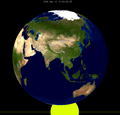
|
| 2067 Nov 21 (Saros 117) |
2096 Oct 31 (Saros 118) |
2125 Oct 12 (Saros 119) | |||

|

|
||||
| 2154 Sep 21 (Saros 120) |
2183 Sep 02 (Saros 121) | ||||
Half-Saros cycle
[edit]A lunar eclipse will be preceded and followed by solar eclipses by 9 years and 5.5 days (a half saros).[8] This lunar eclipse is related to two partial solar eclipses of Solar Saros 122.
| December 25, 2000 | January 6, 2019 |
|---|---|

|

|
See also
[edit]- List of lunar eclipses
- List of 21st-century lunar eclipses
- File:2009-12-31 Lunar Eclipse Sketch.gif Chart
References
[edit]- ^ "December 31, 2009–January 1, 2010 Partial Lunar Eclipse". timeanddate. Retrieved 15 November 2024.
- ^ "Moon Distances for London, United Kingdom, England". timeanddate. Retrieved 15 November 2024.
- ^ "Partial Lunar Eclipse of 2009 Dec 31" (PDF). NASA. Retrieved 15 November 2024.
- ^ "Partial Lunar Eclipse of 2009 Dec 31". EclipseWise.com. Retrieved 15 November 2024.
- ^ van Gent, R.H. "Solar- and Lunar-Eclipse Predictions from Antiquity to the Present". A Catalogue of Eclipse Cycles. Utrecht University. Retrieved 6 October 2018.
- ^ "NASA - Catalog of Lunar Eclipses of Saros 115". eclipse.gsfc.nasa.gov.
- ^ Listing of Eclipses of series 115
- ^ Mathematical Astronomy Morsels, Jean Meeus, p.110, Chapter 18, The half-saros
External links
[edit]- 2009 Dec 31 chart: Eclipse Predictions by Fred Espenak, NASA/GSFC
- Hermit eclipse: 2009-12-31
- [1] Eclipse enthusiasts in Europe, Africa, Australia and Asia can celebrate New Year's Eve by observing a partial lunar eclipse on December 31, 2009. The event's duration will be about four hours.














